Finite Element Analysis of the Mechanical Response for Cylindrical Lithium-Ion Batteries with the Double-Layer Windings
Abstract
:1. Introduction
2. Materials and Methods
2.1. Finite Element Model
2.2. Numerical Simulation Method in Abaqus/Explicit
3. Numerical Results and Discussion
3.1. Calibration of Material Parameters with Crush Simulation
3.2. Indentation of a Cell by a Rigid Rod
3.3. Indentation of a Cell by a Spherical Punch
4. Conclusions
Funding
Institutional Review Board Statement
Informed Consent Statement
Data Availability Statement
Conflicts of Interest
References
- Zhang, X.; Sastry, A.M.; Shyy, W. Intercalation-Induced Stress and Heat Generation within Single Lithium-Ion Battery Cathode Particles. J. Electrochem. Soc. 2008, 155, A542. [Google Scholar] [CrossRef]
- Golmon, S.; Maute, K.; Dunn, M.L. Numerical modeling of electrochemical–mechanical interactions in lithium polymer batteries. Comput. Struct. 2009, 87, 1567–1579. [Google Scholar] [CrossRef]
- Chen, Y.H.; Wang, C.W.; Zhang, X.; Shyy, W.; Sastry, A.M. Porous cathode optimization for lithium cells: Ionic and electronic conductivity, capacity, and selection of materials. J. Power Sources 2010, 195, 2851–2862. [Google Scholar] [CrossRef]
- Arora, P.; Zhang, Z.J. Battery separators. Chem. Rev. 2004, 104, 4419–4462. [Google Scholar] [CrossRef] [PubMed]
- Sheidaei, A.; Xiao, X.; Huang, X.; Hitt, J. Mechanical be-havior of a battery separator in electrolyte solutions. J. Power Sources 2011, 196, 8728–8734. [Google Scholar] [CrossRef]
- Lee, H.; Yanilmaz, M.; Toprakci, O.; Fu, K.; Zhang, X. A review of recent developments in membrane separators for rechargeable lithium-ion batteries. Energy Environ. Sci. 2014, 7, 3857–3886. [Google Scholar] [CrossRef]
- Zhang, X.; Sahraei, E.; Wang, K. Li-ion Battery Separators, Mechanical Integrity and Failure Mechanisms Leading to Soft and Hard Internal Shorts. Sci. Rep. 2016, 6, 32578. [Google Scholar] [CrossRef] [PubMed]
- Sahraei, E.; Hill, R.; Wierzbicki, T. Calibration and finite element simulation of pouch lithium-ion batteries for mechanical integrity. J. Power Sources 2012, 201, 307–321. [Google Scholar] [CrossRef]
- Greve, L.; Fehranbach, C. Mechanical testing and macro-mechanical finite element simulation of the deformation, fracture, and short circuit initiation of cylindrical Lithium ion battery cells. J. Power Sources 2012, 214, 377–385. [Google Scholar] [CrossRef]
- Sahraei, E.; Campbell, J.; Wierzbicki, T. Modeling and short circuit detection of 18650 Li-ion cells under mechanical abuse conditions. J. Power Sources 2012, 220, 360–372. [Google Scholar] [CrossRef]
- Gibson, L.J.; Ashby, M.F. Celluar Solids: Structure and Properties; Cambridge University Press: Cambridge, UK, 1997. [Google Scholar]
- Zhang, J.; Kikuchi, N.; Li, V.; Yee, A.; Nusholtz, G. Constitutive modeling of polymeric foam material subjected to dynamic crash loading. Int. J. Impact Eng. 1998, 21, 369–386. [Google Scholar] [CrossRef]
- Santosa, S.; Wierzbicki, T. Crash behavior of box columns filled with aluminum honeycomb or foam. Comput. Struct. 1998, 68, 343–367. [Google Scholar] [CrossRef]
- Santosa, S.P.; Wierzbicki, T.; Hanssen, A.G.; Langseth, M. Experimental and numerical studies of foam-filled sections. Int. J. Impact Eng. 2000, 24, 509–534. [Google Scholar] [CrossRef]
- Deshpande, V.S.; Fleck, N.A. Isotropic Constitutive Model for Metallic Foams. J. Mech. Phys. Solids 2000, 48, 1253–1276. [Google Scholar] [CrossRef]
- Wang, J.G.; Sun, W.; Anand, S. A microstructural analysis for crushable deformation of foam material. Computat. Mater. Sci. 2008, 44, 195–200. [Google Scholar] [CrossRef]
- Wierzbicki, T.; Sahraei, E. Homogenized mechanical properties for the jellyroll of cylindrical Lithium-ion cells. J. Power Sources 2013, 241, 467–476. [Google Scholar] [CrossRef]
- Ahn, Y.J. Calibration of Crushable Foam Models for the Jellyroll of Cylindrical Lithium-Ion Batteries. Energies 2024, 17, 1360. [Google Scholar] [CrossRef]
- Ahn, Y.J.; Lee, Y.S.; Cho, J.R. Multi-Layered Numerical Model Development of a Standard Cylindrical Lithium-Ion Battery for the Impact Test. Energies 2022, 15, 2509. [Google Scholar] [CrossRef]
- Abaqus Reference Manual; R2022x; Dassault Systems Simulia Corp.: Johnston, RI, USA, 2022.
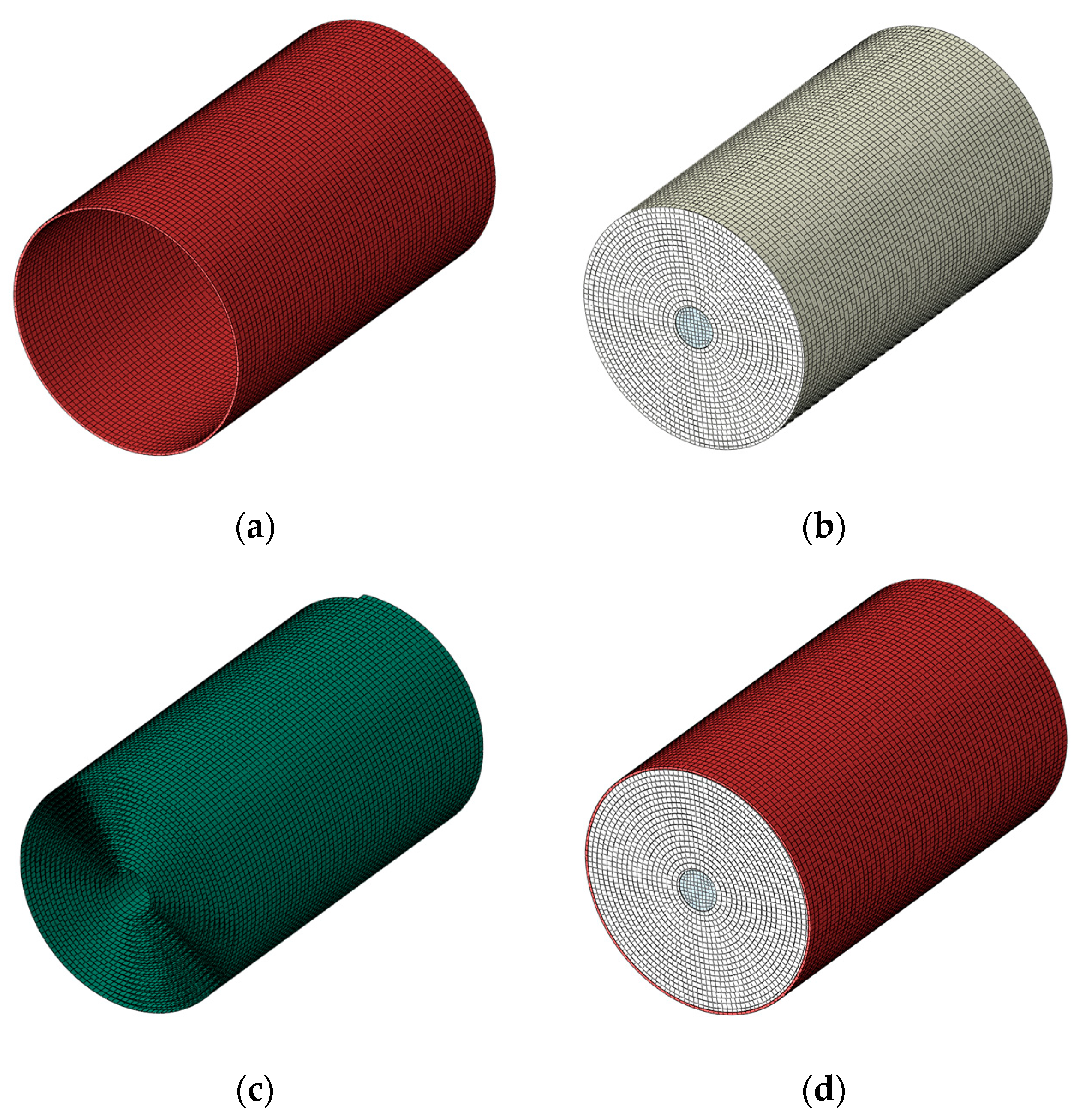

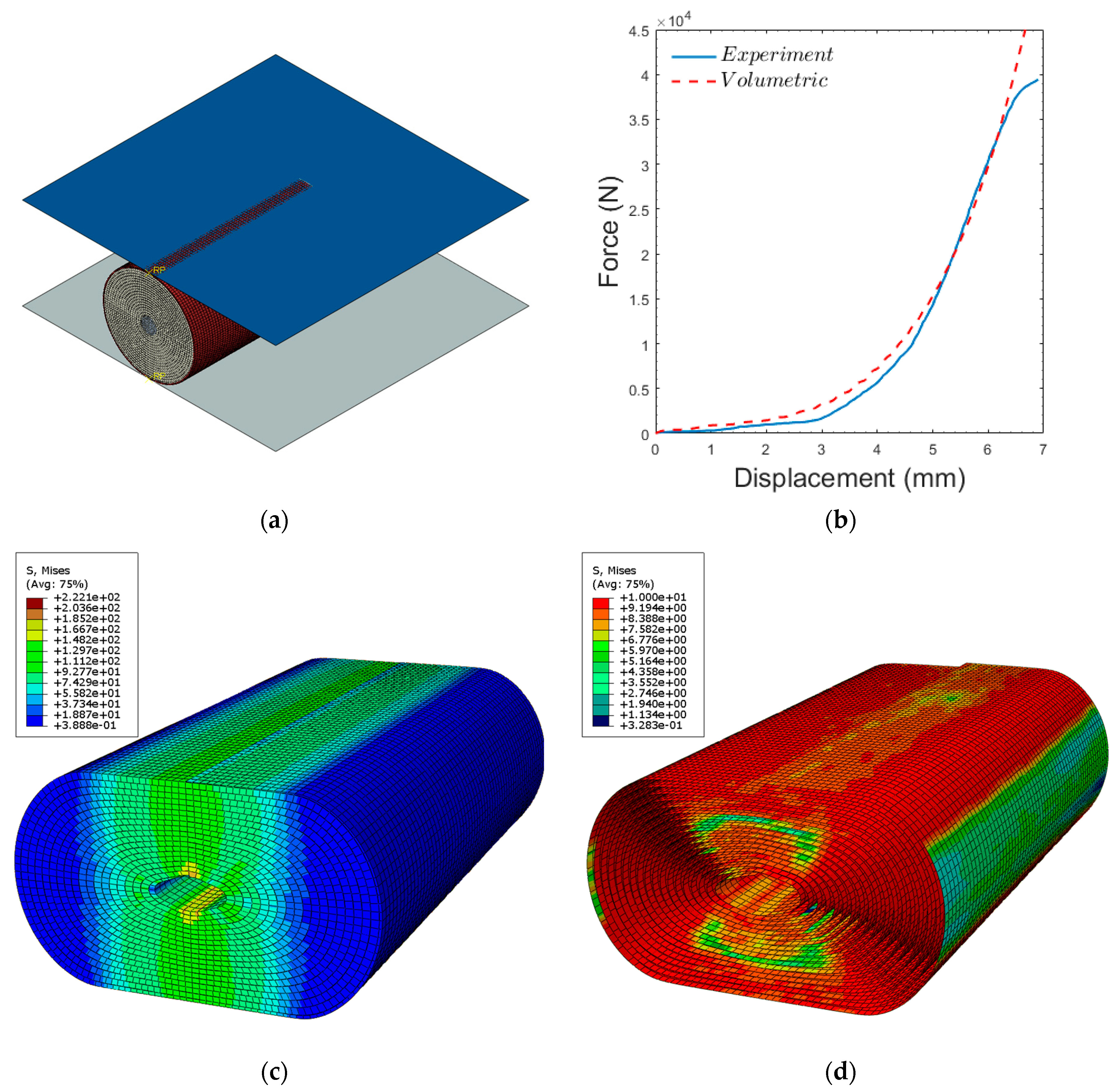
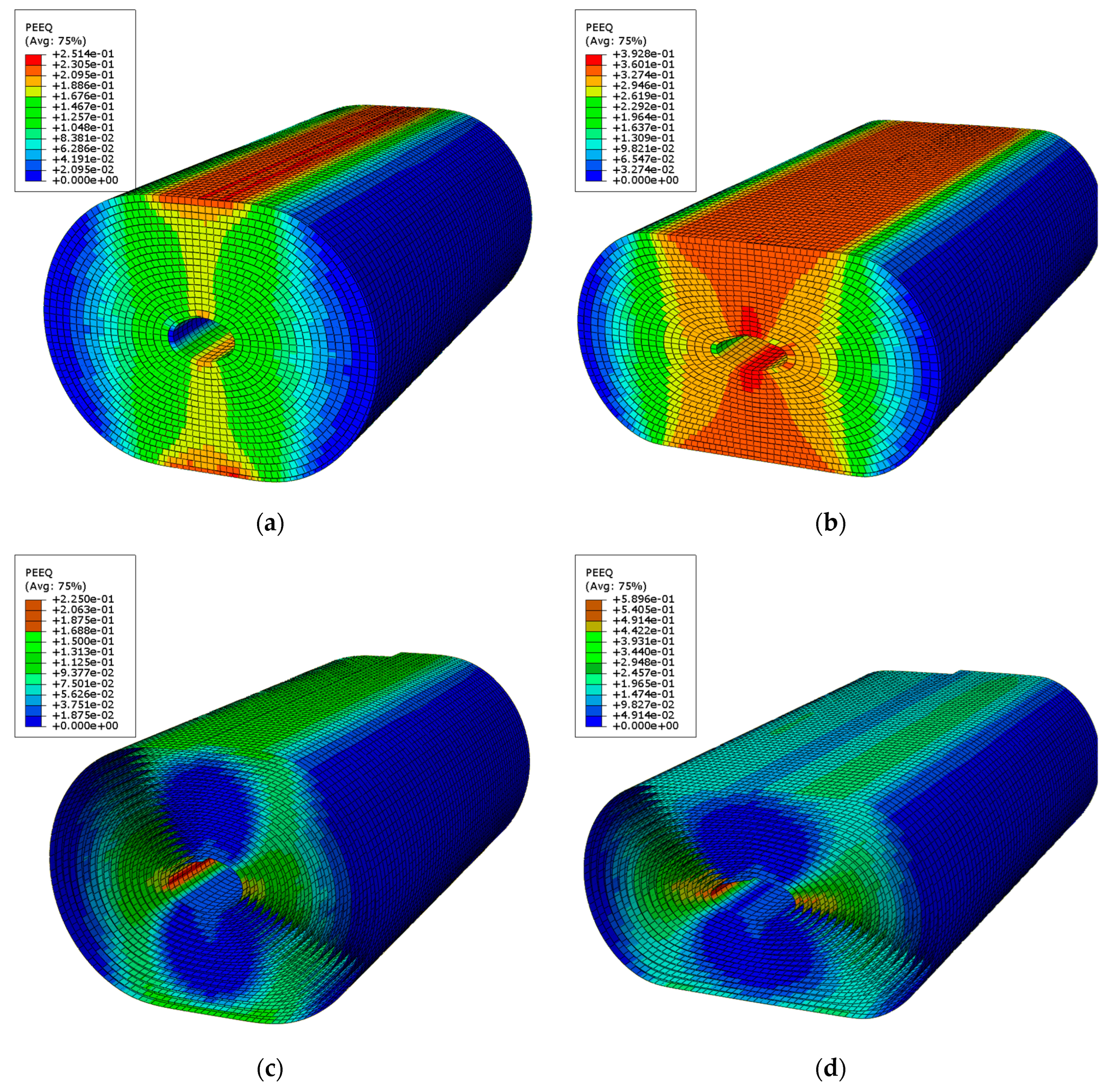
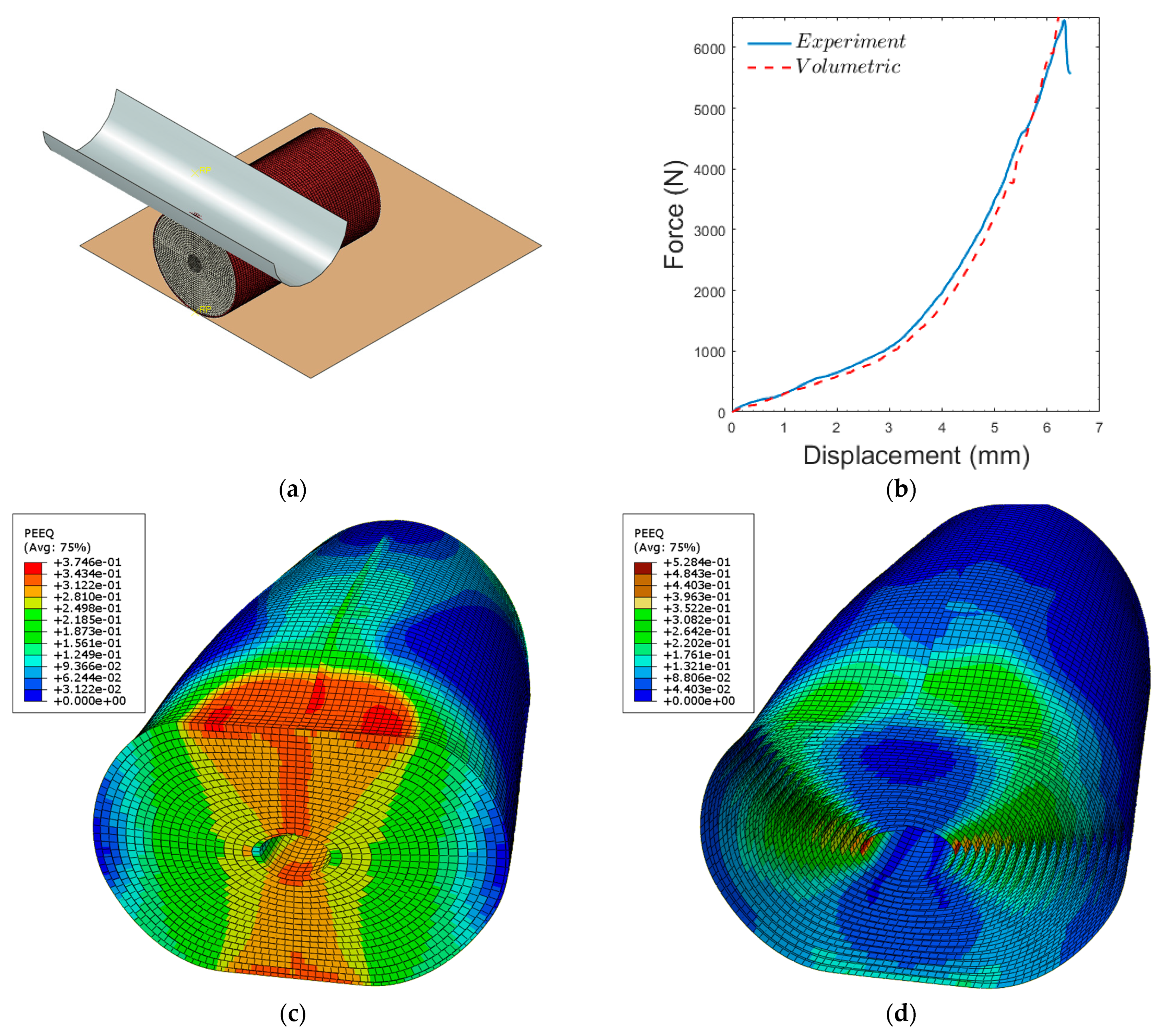
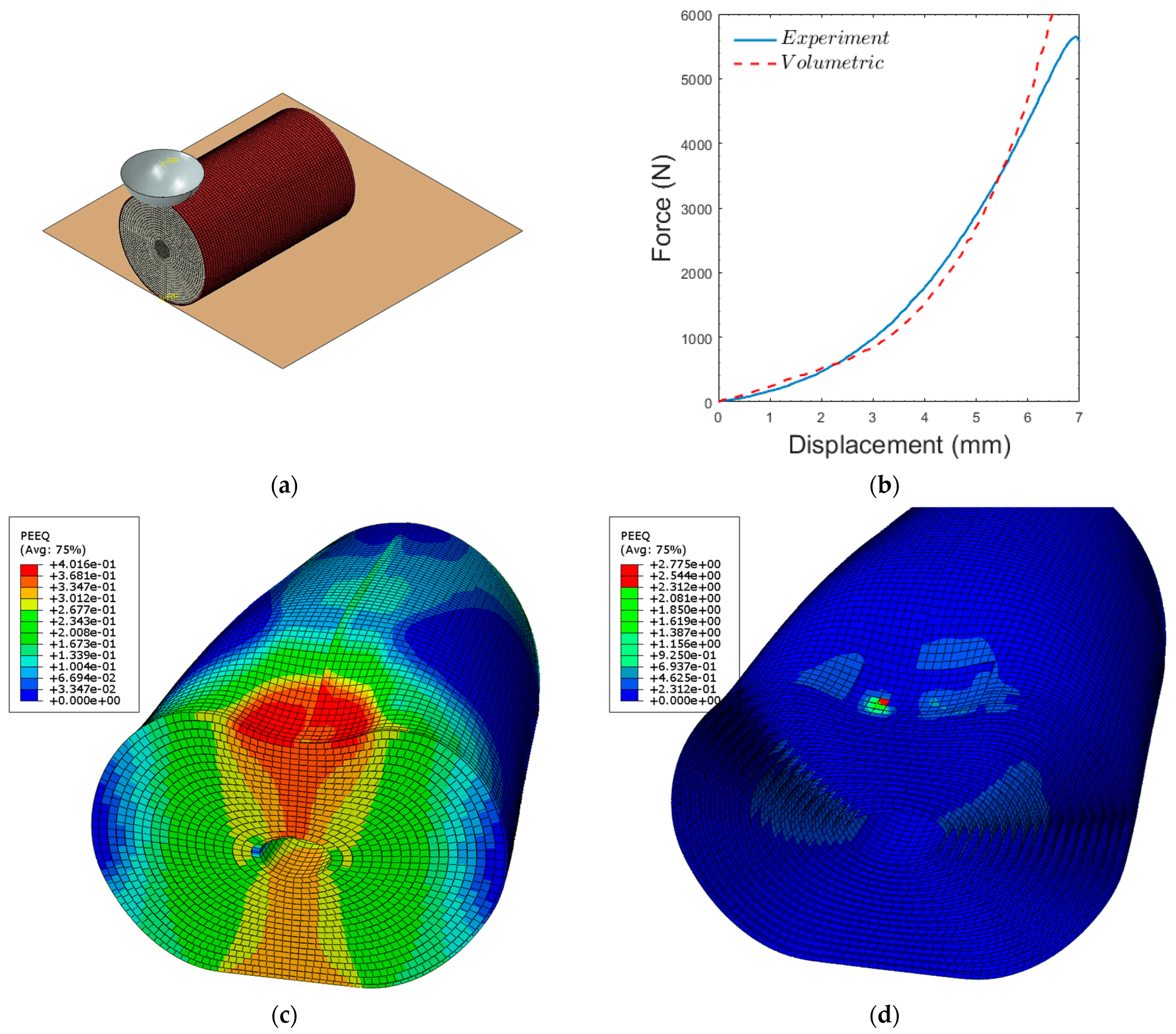
| Parts | Neutral Radius (mm) | Thickness (mm) | Length (mm) |
|---|---|---|---|
| Casing (w/o endcaps) | 8.9 | 0.18 | 31 |
| Jellyroll with core (18 turns) | 1.43 (starting) | 0.4 | 30 |
| 8.9 (ending) | |||
| Thin-layered roll (18 turn) | 1.53 (starting) | 0.016 | 30 |
| 8.9 (ending) |
| Parts | Boundary Condition |
|---|---|
| Casing and center-pin | Symmetry condition in the middle plane |
| Jellyroll | Symmetry condition in the middle plane at the edge of both the beginning and the ending of the winding |
| Indenter | All movements constrained except in the vertical direction |
| Rigid floor | All movements constrained |
| Parameter | ||||
|---|---|---|---|---|
| Value | 1500 | 0 | 2.7 | 1.0 |
Disclaimer/Publisher’s Note: The statements, opinions and data contained in all publications are solely those of the individual author(s) and contributor(s) and not of MDPI and/or the editor(s). MDPI and/or the editor(s) disclaim responsibility for any injury to people or property resulting from any ideas, methods, instructions or products referred to in the content. |
© 2024 by the author. Licensee MDPI, Basel, Switzerland. This article is an open access article distributed under the terms and conditions of the Creative Commons Attribution (CC BY) license (https://creativecommons.org/licenses/by/4.0/).
Share and Cite
Ahn, Y.J. Finite Element Analysis of the Mechanical Response for Cylindrical Lithium-Ion Batteries with the Double-Layer Windings. Energies 2024, 17, 3357. https://doi.org/10.3390/en17143357
Ahn YJ. Finite Element Analysis of the Mechanical Response for Cylindrical Lithium-Ion Batteries with the Double-Layer Windings. Energies. 2024; 17(14):3357. https://doi.org/10.3390/en17143357
Chicago/Turabian StyleAhn, Young Ju. 2024. "Finite Element Analysis of the Mechanical Response for Cylindrical Lithium-Ion Batteries with the Double-Layer Windings" Energies 17, no. 14: 3357. https://doi.org/10.3390/en17143357





